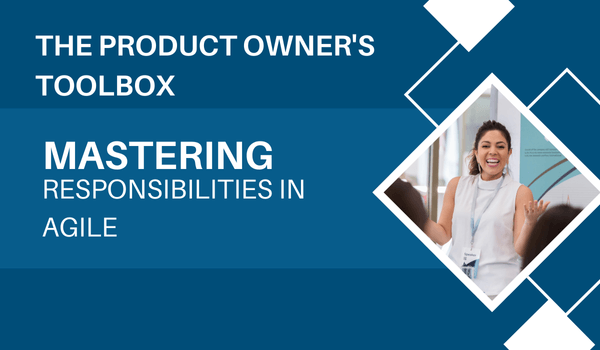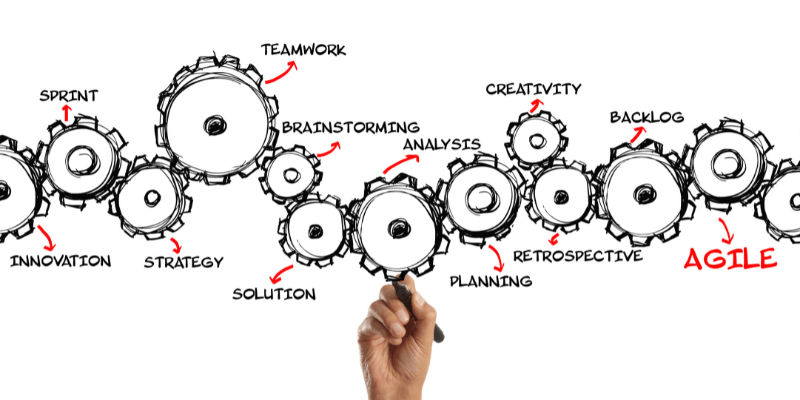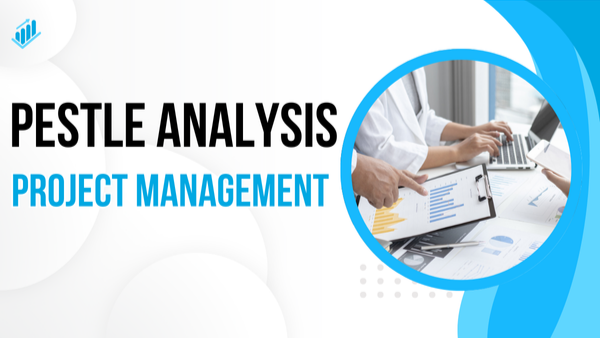
The Product Owner's Toolbox: Mastering Responsibilities in Agile
The rise of Agile methodologies has brought significant changes to how teams approach project management. Central to the success of Agile teams is the role of the Product Owner, who acts as a bridge between stakeholders and development teams.
Table of Contents
- Understanding the role of a product owner in agile
- Key responsibilities of a product owner
- The importance of the product owner in agile teams
- Tools for effective product ownership
- Prioritization techniques for backlog management
- Communication tools for stakeholder engagement
- Mastering agile methodologies as a product owner
- Embracing the agile mindset
- Implementing scrum and kanban practices
- Overcoming challenges in product ownership
- Balancing stakeholder expectations and team capacity
- Navigating uncertainty and change in agile projects
- Continuous improvement as a product owner
- Leveraging feedback for product improvement
- The role of retrospectives in process enhancement
This article delves into the core responsibilities of a Product Owner, the tools that facilitate these responsibilities, and strategies for overcoming challenges in the Agile landscape.
For those looking to deepen their expertise and take on the role of a Product Owner, Certifyera offers an Agile Product Owner Certification, a live course that serves as the perfect complement to mastering the responsibilities.
Understanding the Role of a Product Owner in Agile
The Product Owner is a critical role within Agile frameworks, particularly in Scrum. This individual is responsible for defining product vision, managing the product backlog, and ensuring that the development team delivers maximum value to stakeholders. The Product Owner must possess strong communication skills and an understanding of both customer needs and business goals.
One of the unique aspects of the Product Owner role is its duality. On one hand, the Product Owner advocates for the customer and ensures that user stories and features meet their needs. On the other hand, the role also involves collaborating closely with the development team, providing clarity on requirements, and removing any obstacles that may hinder progress.
Key Responsibilities of a Product Owner
Product Owners have a variety of responsibilities that are integral to the successful operation of Agile teams. Some of the key responsibilities include:
-
Defining the Product Vision: The Product Owner articulates a clear vision for the product, which guides the team in their development efforts.
-
Managing the Product Backlog: This involves curating and prioritizing the backlog, ensuring that it reflects customer and business needs.
-
Engaging Stakeholders: Regular communication with stakeholders helps gather feedback and align the product direction with their expectations.
-
Clarifying Requirements: The Product Owner translates business needs into user stories that the development team can understand and implement.
The Importance of the Product Owner in Agile Teams
The role of the Product Owner is vital for the agility and success of product development. First and foremost, the Product Owner ensures that the team is focused on delivering value. By maintaining an appropriately prioritized backlog, they help the team work on the most impactful features first.
Moreover, the Product Owner fosters a collaborative culture by bridging gaps between the development team and stakeholders. This role encourages feedback loops, enabling timely adjustments based on user input, which enhances product quality and user satisfaction.
Additionally, the Product Owner plays a crucial role in ensuring that the team adheres to Agile principles. They must be adept at facilitating discussions and workshops that promote a shared understanding of goals among team members. By engaging in regular sprint reviews and retrospectives, the Product Owner not only assesses the progress of the product but also encourages continuous improvement within the team. This iterative process allows for the identification of potential challenges early on, enabling the team to pivot or adjust their approach as necessary.
Furthermore, the Product Owner is often seen as the face of the product, representing it both internally and externally. This includes participating in marketing discussions, aligning product features with market trends, and sometimes even engaging with customers directly to gather insights. Their deep understanding of the market landscape allows them to make informed decisions that can significantly influence the product's success and longevity in a competitive environment.
Tools for Effective Product Ownership
To function effectively, Product Owners rely on a variety of tools and techniques. These tools help streamline processes, improve communication, and facilitate decision-making, ultimately enhancing the product development lifecycle. By leveraging the right tools, Product Owners can not only manage their teams more efficiently but also ensure that the end product aligns closely with customer needs and business objectives.
Prioritization Techniques for Backlog Management
Prioritizing the product backlog is one of the most crucial tasks for a Product Owner. A few effective prioritization techniques include:
-
MoSCoW Method: This method categorizes items into Must have, Should have, Could have, and Won't have, helping teams focus on critical features.
-
Value vs. Effort Matrix: This visual tool helps assess the value and required effort for each backlog item, guiding the decision-making process.
-
Kano Model: This technique differentiates features that satisfy basic user needs from those that delight users, facilitating informed prioritization.
In addition to these methods, Product Owners often utilize the Weighted Shortest Job First (WSJF) approach, which considers the cost of delay and job size to prioritize tasks effectively. This technique can be particularly useful in environments where multiple projects compete for limited resources, allowing teams to maximize value delivery. Furthermore, regular backlog grooming sessions can ensure that the backlog remains relevant and aligned with the evolving market conditions and user feedback, fostering a more agile development process.
Communication Tools for Stakeholder Engagement
Open communication is paramount for a Product Owner. Several tools can enhance stakeholder engagement, including:
-
Jira: A popular tool that helps track issues and backlogs while providing visibility for stakeholders into the project's progress.
-
Trello: A flexible board system that allows teams and stakeholders to visualize task progress and prioritize projects effectively.
-
Slack: A communications platform that enables real-time discussions, making it easier for Product Owners to share updates and gather feedback.
Beyond these tools, Product Owners may also employ video conferencing platforms such as Zoom or Microsoft Teams to facilitate face-to-face interactions, which can strengthen relationships and enhance collaboration among remote teams. Regular stakeholder meetings, whether formal or informal, can also provide valuable opportunities for Product Owners to gather insights and feedback, ensuring that everyone remains aligned on project goals. Additionally, utilizing collaborative documentation tools like Confluence can help maintain a single source of truth for project documentation, making it easier for stakeholders to access critical information and stay informed throughout the development process.

Mastering Agile Methodologies as a Product Owner
To be effective, Product Owners must embody the principles of Agile. This involves not only understanding Agile frameworks but also cultivating the Agile mindset to navigate complexities confidently.
Embracing the Agile Mindset
The Agile mindset encourages adaptability, collaboration, and a focus on delivering value. For a Product Owner, this means being open to change and actively seeking feedback from all stakeholders.
Moreover, practicing transparency helps build trust within the team and with stakeholders. By openly sharing progress updates, challenges, and decision rationales, the Product Owner fosters a culture of learning and continuous improvement.
Additionally, embracing an Agile mindset involves a commitment to iterative development. This means recognizing that perfection is often an evolving target and that initial versions of a product can be refined based on user feedback and testing. By prioritizing user stories and focusing on the most valuable features first, Product Owners can ensure that the team is aligned with customer needs and market demands. This iterative approach not only enhances product quality but also empowers teams to innovate and experiment without the fear of failure.
Implementing Scrum and Kanban Practices
Understanding and effectively implementing frameworks such as Scrum and Kanban is crucial for Product Owners. In Scrum, the Product Owner participates in sprint planning, reviews, and retrospectives, ensuring that all work aligns with the product vision.
In contrast, Kanban emphasizes continuous delivery. The Product Owner ensures that work-in-progress limits are respected and that the team focuses on completing tasks before taking on new ones. Both practices require the Product Owner to balance stakeholder input and team capacity to maintain an efficient workflow.
Furthermore, integrating metrics and performance indicators into these frameworks can significantly enhance a Product Owner's effectiveness. By utilizing tools such as burndown charts in Scrum or cumulative flow diagrams in Kanban, Product Owners can gain valuable insights into team performance and project health. This data-driven approach allows for informed decision-making and helps identify bottlenecks early, enabling timely interventions. Ultimately, the ability to analyze and adapt based on these metrics is a hallmark of a successful Product Owner, ensuring that the team remains agile and responsive to both challenges and opportunities.
Overcoming Challenges in Product Ownership
Product ownership comes with its own set of challenges. Navigating these obstacles efficiently is essential for maintaining a productive team and delivering a successful product.
Balancing Stakeholder Expectations and Team Capacity
One of the significant challenges is aligning stakeholder expectations with the development team's capacity. A Product Owner must not only understand stakeholder desires but also appreciate the team's limitations.
This balance can be achieved through effective communication, setting realistic timelines, and ensuring that the product backlog reflects both stakeholder priorities and team capacity. Regular check-ins with stakeholders can also help reset expectations when necessary. Additionally, employing visual tools such as burn-down charts or Kanban boards can provide stakeholders with a clearer understanding of progress and potential bottlenecks, fostering a collaborative environment where everyone is informed and engaged in the process.
Navigating Uncertainty and Change in Agile Projects
In a dynamic environment, uncertainty and changes are unavoidable. Product Owners must embrace these factors and adapt their strategies accordingly. This adaptability involves regularly refining the product backlog based on user feedback, market trends, and emerging technologies.
Utilizing techniques such as rapid prototyping allows for quick iterations, helping teams respond effectively to changes without derailing progress. Furthermore, fostering a mindset of resilience within the team cultivates confidence when facing inevitable shifts in direction. Encouraging team members to share their insights and experiences can also enhance collective problem-solving capabilities, enabling the team to pivot swiftly and effectively. By creating a culture of continuous learning and experimentation, Product Owners can empower their teams to innovate and thrive amidst uncertainty.
Continuous Improvement as a Product Owner
For Product Owners, continuous improvement is critical not only for the product but also for their personal growth and team dynamics. Embracing a culture of learning and insight can lead to significant advancements in product strategy.
Leveraging Feedback for Product Improvement
Feedback is a powerful tool for growth. Product Owners should regularly solicit input from users, stakeholders, and team members. Implementing tools such as surveys, user testing sessions, and usability studies can provide valuable insights into how the product is being received.
The key is to analyze this feedback and make informed decisions regarding future iterations. This iterative process ensures that the product evolves in line with user expectations and market demands.
The Role of Retrospectives in Process Enhancement
Retrospectives are an integral part of the Agile process, giving teams the opportunity to reflect on their work and identify areas for improvement. For Product Owners, facilitating these sessions can uncover valuable insights into both process and product.
By encouraging open dialogue during retrospectives, Product Owners can identify bottlenecks, celebrate successes, and develop actionable items to enhance team performance. This practice of continuous reflection leads to sustained improvements, benefiting both the product and the team.
In conclusion, the role of a Product Owner is multifaceted and critical to the success of Agile projects. By mastering their responsibilities, leveraging the right tools, and committing to continuous improvement, Product Owners can significantly influence the effectiveness of their teams and the success of their products. Emphasizing adaptability and open communication further enhances their ability to navigate the complexities of product management in an Agile environment.

About Anita Ankam
Anita Ankam – Expert Project Management Instructor
Anita Ankam is a highly experienced and certified project management instructor, specializing in globally recognized methodologies such as PMP®, PMI-ACP®, DASM®, and DASSM®. With an extensive academic background, including an MBA and MSc, Anita holds multiple industry-leading certifications, including PRINCE2, PRINCE2 Agile Practitioner, CSM, ASM, ITIL, and Six Sigma Black Belt.
As an authorized training instructor, Anita has guided countless professionals in mastering project management frameworks and agile practices. Know more.
Related Posts

Featured Links
Contact us
- PMP® Certification Course |
- CAPM Certification Course |
- PMP Certification Training in Mumbai |
- PMP Certification Training in Pune |
- PMP Certification Training in Hyderabad |
- PMP Certification Training in Delhi |
- PMP Certification Training in Chennai |
- PMP Certification Training Course in Ahmedabad |
- PMP Certification Training Course in Bangalore |
- PMP Certification Training Course in Bhubaneswar |
- PMP Certification Training Course in Chandigarh |
- PMP Certification Training Course in Gandhinagar |
- PMP Certification Training Course in Faridabad |
- PMP Certification Training Course in Dombivli |
- PMP Certification Training Course in Coimbatore |
- PMP Certification Training Course in Ghaziabad |
- PMP Certification Training Course in Gurgaon |
- PMP Certification Training Course in Indore |
- PMP Certification Training Course in Jaipur |
- PMP Certification Training Course in Mysore |
- PMP Certification Training Course in Lucknow |
- PMP Certification Training Course in Kolkata |
- PMP Certification Training Course in Kochi |
- PMP Certification Training Course in Nagpur |
- PMP Certification Training Course in Navi Mumbai |
- PMP Certification Training Course in Patna |
- PMP Certification Training Course in Pimpri |
- PMP Certification Training Course in Vadodara |
- PMP Certification Training Course in Trivandrum |
- PMP Certification Training Course in Thane |
- PMP Certification Training Course in Surat |
- PMP Certification Training Course in Noida |
- PMP Certification Training Course in Visakhapatnam |
- PMP® Certification Training Course in Doha |
- PMP Certification Training in New York |
- PMP Certification Training Course in Chicago |
- PMP Certification Training in Austin |
- PMP Certification Training in Minneapolis |
- PMP Certification Training in Atlanta |
- PMP Certification Training in Dallas |
- PMP Certification Training in San Diego |
- CAPM Certification Training in Mumbai |
- CAPM Certification Training in Bangalore |
- CAPM Certification Training in Hyderabad |
- CAPM Certification Training in Delhi |
- CAPM Certification Training in Pune |
- CAPM Certification Training in Chennai |
- CAPM certification Training in Kolkata |
- CAPM certification Training in Gurgaon |
- CAPM certification Training in Noida |
- CAPM Certification Training in Ahmedabad |
- PMI Certified Professional in Managing AI (PMI-CPMAI)™ |
- PMI-RMP - PMI Risk Management Professional |
- PMI-PMOCP - PMI® Project Management Office Certified Professional
- AZ-900: Microsoft Azure Fundamentals |
- AZ-104: Microsoft Azure Administrator |
- AZ-204: Developing Solutions for Microsoft Azure |
- AZ-305: Designing Microsoft Azure Infrastructure Solutions |
- AZ-400: Designing and Implementing Microsoft DevOps Solutions |
- AZ-500: Microsoft Azure Security Technologies |
- AI-900: Microsoft Azure AI Fundamentals |
- DP-900: Microsoft Azure Data Fundamentals |
- CLF-C02: AWS Certified Cloud Practitioner |
- GCP-FC: Cloud Digital Leader |
- GCP-ACE: Associate Cloud Engineer |
- GCP-PCA: Professional Cloud Architect |
- GCP-PCD: Professional Cloud Developer |
- GCP-PCE: Professional Cloud DevOps Engineer |
- GCP-PDE: Professional Data Engineer |
- GCP-PCNE: Professional Cloud Network Engineer |
- GCP-PCSE: Professional Cloud Security Engineer |
- GCP-ML: Professional Machine Learning Engineer |
- GCP-PBA: Professional Business Intelligence Analyst |
- DP-100: Designing and Implementing a Data Science Solution on Azure |
- DP-203: Data Engineering on Microsoft Azure
- PMP® is a registered mark of the Project Management Institute, Inc.
- CAPM® is a registered mark of the Project Management Institute, Inc.
- PMI-ACP® is a registered mark of the Project Management Institute, Inc.
- Certified ScrumMaster® (CSM) ia a registered trademark of SCRUM ALLIANCE®
- While we strive to ensure that all prices listed on our website are accurate, we reserve the right to modify them at any time without prior notice.
Copyright © Certifyera Consulting Services. All Rights Reserved | Designed and Developed by WebAnaya


